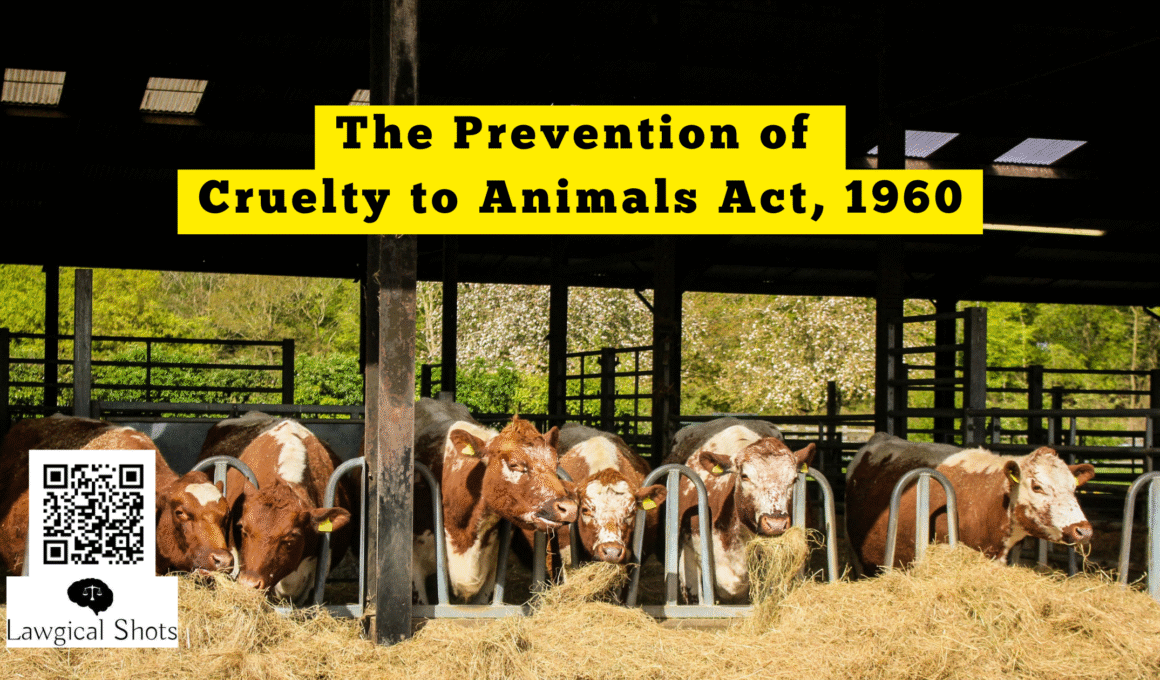The Prevention of Cruelty to Animals Act is a landmark statute in terms of protecting animals from all forms of cruelty. The purpose is to prevent unnecessary pain and suffering inflicted on animals. This Act provides comprehensive guidelines to avoid animal suffering and promote humane treatment across all sectors.
Scope and Application of Animal Cruelty Law
The Prevention of Cruelty to Animals Act applies throughout India, covering all domesticated animals, livestock, and captive animals (the animals which are kept in confinement, whether permanent or temporary). While the primary focus of this Act is to prevent any suffering of animals under human control, its principles cover broader animal protection policies.
- It defines different forms of animals protected under The Prevention of Cruelty to Animals Act, 1960, such as domestic animals, captive animals.
- It lays down the framework for the constitution of the Animal Welfare Board and its powers and functions related to it.
- It covers different types of cruelty, along with exceptions and punishments outlined in it.
- It outlines the rules for conducting experiments on animals for scientific purposes.
- It also lays down the provisions allowing the killing of animals suffering from inflicted pain to relieve them from further suffering.
Legal Framework under Prevention of Cruelty to Animals Act, 1960
Establishment of Animal Welfare Board
To protect animals from unnecessary pain and suffering, the Central Government shall establish the board. The following are the functions of the Animal Welfare Board, as described in Prevention of Cruelty to Animals Act:
- To review the law in India to protect animals from unnecessary suffering and pain and recommend necessary amendments to the Government from time to time.
- To advise the Government or local authority for built and maintenance of slaughterhouses, the construction of sheds, water-troughs, and veterinary assistance to animals.
- To encourage, by grant of financial assistance or otherwise, for the establishment of rescue homes, animal shelters, and pinjrapoles to provide shelters to old and useless animals
- To provide financial or other assistance to animal welfare organization working in the local area and encourage the formation of such organization, which shall work under the general supervision and guidance of the board.
- To advise the Government regarding medical care and financial assistance to the hospital.
- To impart education about humane treatment of animals and to encourage formation of public opinion against the infliction of unnecessary pain or suffering to animals.
Forms of Cruelty under The Prevention of Cruelty to Animals Act, 1960
- Specific prohibited acts such as beats, kicks, over-rides, over-loads, tortures, or handling animals in a way that causes them avoidable pain or distress;
- Employ any animals which, because of their age or any disease, are unfit to be employed;
- Willfully and unreasonably administers any injurious drugs or substances;
- Keep or confine any animals in any cage which does not meet a sufficiently specific standard as prescribed under the Act;
- Being the owner of any animals fails to provide enough food, drink, or shelter to the animals;
- Without reasonable reason, abandons any animal in circumstances that put it at risk of pain caused by starvation or thirst; or willfully permits any animal which is affected by contagious or infectious disease to go at large in a street or to die in any street;
- Without reasonable reason, has in his possession any animal which is suffering from mutilation, starvation, thirst, or any other ill-treatment;
- Confines any animals to make them objects of prey for any other animals;
- Incites any animal to fight or trap any other animal;
- Promotes or takes part in any shooting match or competition wherein animals are released from captivity;
Experimentation on Animals
Under the Act, experimentation on animals is regulated to ensure that animals are not subjected to unnecessary pain or suffering. The Act permits experimentation for the purpose of advancement by new discovery of physiological knowledge or of knowledge which will be useful for saving or combating any disease, but only under strict guidelines and ethical oversight. The Committee for the Purpose of Control and Supervision of Experiments on Animals was established under this Act to monitor and regulate animal experimentation.
Performing Animals under Animal Cruelty Act
Under this provision of the Act, a restriction is imposed on the exhibition, which means at any entertainment place where the public showed up through the sale of tickets. and training, wherein Animals are trained for the purpose of entertainment. No person shall exhibit or train:
- Any performing animal unless it is registered in accordance with the provisions of the Chapter V of the Act;
- For any performing animal, if the Central Government may, by notification in the Official Gazette, specify that particular animal shall not be exhibited or trained as a performing animal.
Penalties and Enforcement
Violation of any of the above provisions shall attract a fine and imprisonment for a term as prescribed under the Act. There is a distinction between first-time and repeat offenders, with enhanced punishments for habitual violators to encourage proportionate justice.
Exemptions and Permitted Activities
- The Act recognized legitimate uses of animals in agriculture, transportation, and religious practices while establishing humane standards;
- The training of animals for bona fide military or police purposes or the exhibition of any animals so trained;
- Any animals kept in a zoological garden or by any society or association, wherein the principal object behind it shall be educational and for scientific purposes.
Challenges in Prevention of Cruelty to Animals
Despite a comprehensive legislative framework, it faces challenges such as limited awareness, insensitivity towards animals, inadequate enforcement, cultural constraints, especially in rural areas where people are engaged in such an activity, which may be against the provision of the Act, such as bull fighting or inciting a fight between two animals, animals’ race in inhumane conditions. The penalty structure of the Act requires updating to be update reflect the contemporary scenario and provide effective deterrence for the proper implementation of The Act without compromising the purpose of the Act.
Conclusion
The Prevention of Cruelty to Animals Act, 1960, is one of India’s foundational laws for the protection of animals against unnecessary pain and suffering inflicted upon them. It provides a necessary framework for the protection of animals, covering the broader aspects from domestic to captive animals, while encouraging humane treatment towards animals from all sections of society. The legislation stands as a testament to the nation’s commitment to compassionate treatment of all living beings, reflecting the values of non-violence and moral responsibilitiesthat define the ethos of Indian Civilization.
The Prevention of Cruelty to Animals Act, 1960 has been summarised by our intern, Ms Neha Patidar. She has been assisting the team in bringing informational legal blogs.








